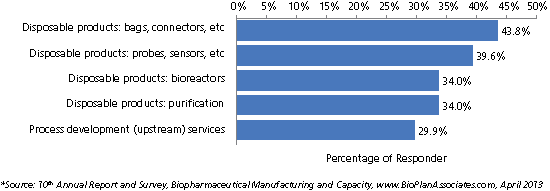Disposable Applications in Demand for BioPharma
PTSM: Pharmaceutical Technology Sourcing and Management
Interest in chromatography innovation continues to decline.
It’s becoming harder to ignore the rapid emergence and impact of single-use devices on biomanufacturing. Data from BioPlan Associates’ 10th Annual Report and Survey of Biopharmaceutical Manufacturing Capacity and Production suggest that the interest in disposable devices has begun to extend to biopharma operations beyond basic single-use bags and connectors (1).
BioPlan Associates asked more than 200 biopharma industry decision-makers to identify the top areas they want their suppliers to focus their new product development on. Four disposable device categories top the list, each cited by more than one-third of respondents (see Figure 1): disposable products, bags and connectors (43.8%); disposable probes and sensors (39.6%); disposable bioreactors (34%); and disposable purification products (also 34%).
Rounding out the top five innovation areas were process development (upstream) services (29.9%), followed by analytical assays (27.1%), process development (downstream) services (26.4%), and analytical development (26.4%).
It’s not a surprise to see bags and connectors top the list. This area has been a growing trend over the past five years. While many respondents separately said they expect to see fully disposable facilities in the next five years, the predominant single-use paradigm still involves dropping multi-layer plastic laminated bags/liners into what are basically classic-design stainless-steel bioreactors, mixers, and other fluid containers. The majority of vendors are behind this approach, particularly as they invested heavily in expensive bag-making facilities in the past few years. This approach, though, may actually stifle long-term innovation--as vendors won’t be focusing as much on other more innovative product lines in the near future.
Aside from bags and connectors, there is continuing demand for improvements in single-use bioprocessing sensors and probes. Currently, few single-use sensors are sufficiently robust, and sensors are restricted to relatively few analytes. Relatively few single-use sensor products are currently available, and there are often issues regarding ports and how to pass single-use sensors through bioreactors and other vessels and their bag liners.
The industry is likely to see innovation in tubing and connectors, many targeted to replace and/or be cheaper than silicone, including fluoropolymers tubing, fluoropolymer-lined tubing, and new thermoplastics blended tubing. Many of these new tubing options will provide improved performance compared with silicone, likely by being heat-sterilizable at higher temperatures, lasting longer, and resulting in less leaching from plastics.
Single-use innovation
Several trends are driving innovation interest in single-use equipment. Greater application of quality-by-design (QbD) principles in manufacturing stimulates interest in probes and sensors. Similarly, innovation in probes and sensors is fueled by commercial interest in biosimilars and biobetters, which require the ability to demonstrate rigorous, extensive, and robust comparability.
Results from BioPlan’s study show that disposable innovation is growing. Interest in new disposable products is up in this year’s survey, and bags and connectors represent the highest level in at least the past four years at 43.8% of respondents (up from 38.9% in 2010). The same is true for disposable probes and sensors, up from 29.3% of respondents in 2010 to 39.6% in 2013.
Interest for improved cell-culture media is down to 25% this year from 35.4% in 2010, suggesting that these products have improved sufficiently relative to the hurdles in other areas of bioprocessing, such as downstream processing. The pendulum may be swinging back from downstream problems, as other product areas experiencing a relative decrease this year in demand for improvements include: process development (downstream) services (26.4% this year versus 34.9% in 2010); chromatography products (25% vs. 36.7%); and general separation products (16.7%, from 20.5%).
Disposable purification product innovation
BioPlan evaluated the differences between how respondents at biotherapeutic developers and CMOs viewed the need for innovation. The two groups’ perspectives were quite different.
The most dramatic differences were seen with disposable purification products, with 61.1% of CMOs citing this as an area of innovation interest, more than twice the rate for developers, at 30.2%. CMOs are generally involved with many more and diverse products compared to innovator companies and see more issues with purification than developers.

Aside from disposable purification products, CMOs expressed slightly less interest than developers in disposable product innovation (most notably for probes and sensors), surprising given that disposables provide the flexibility and rapid turnaround required by CMOs. Areas where CMOs had more interest compared to product developers included process development and downstream services, analytical development, process development and formulation, validation, and instrumentation.
On a regional basis, interest in disposable bags and connectors was fairly consistent across the United States (47.7%) and Western Europe (45.7%). US respondents were more attracted to innovation in disposable probes and sensors compared with Western Europeans (46.5% and 31.4%, respectively) and disposable bioreactors (38.4% vs 31.4%), while the opposite was true with respect to disposable purification products (34.9% and 42.9%, respectively).
Respondents in the rest of the world in general were less interested in disposable innovation and more interested in services. Bioprocessing products are marketed and readily available worldwide, while many countries lack bioprocessing critical mass and infrastructure and have fewer CMO and CRO services available.
Downstream innovation
Improvements in upstream manufacturing have greatly improved yields in recent years, much of this due to improved cell lines and expression systems. With enhancements in these and other areas, users are now expressing desires for comparable improvements in downstream purification.
BioPlan’s study suggests that upstream improvements are now more highly desired than downstream improvements despite downstream still being very much a problem area compared to upstream bioprocessing. Why users desire better bags and connectors over better downstream technology, where most of the bottlenecks are, is up for debate. Users are generally experienced in the bag-in-a-vessel paradigm, not seeing any substantial technological changes or progress with these products since their launch about a decade ago while advances in upstream manufacture are more common and are moving more into the mainstream, such as tangential flow filtration chromatography and new Protein A products and alternatives.
Nevertheless, downstream purification processes remain little changed and are increasingly the major limiting factor in commercial-scale biopharmaceutical manufacture. It would be expected--certainly if CMOs are to be seen as leading indicators--that purification will become a more highly sought area for which product improvements are desired.
Reference
1. BioPlan Associates, 10th Annual Report and Survey of Biopharmaceutical Manufacturing Capacity and Production (Rockville, MD, April 2013)

About the Author
Eric Langer is the president of BioPlan Associates, tel. 301.921.5979, elanger@bioplanassociates.com.
Transformations in Drug Development for Cell and Gene Therapies
March 28th 2025As a recognized leader in immunophenotyping for clinical trials, Kevin Lang from PPD discusses how spectral flow cytometry is transforming drug development, particularly in cell and gene therapies like CAR-T. He also dives into his award-winning research, including his 2024 WRIB Poster Award-winning work, and his insights from presenting at AAPS PharmSci360.
Advancing Clinical Trials with Spectral Flow Cytometry: A Conversation with Kevin Lang
March 28th 2025As a recognized leader in immunophenotyping for clinical trials, Kevin Lang from PPD discusses how spectral flow cytometry is transforming drug development, particularly in cell and gene therapies like CAR-T. He also dives into his award-winning research, including his 2024 WRIB Poster Award-winning work, and his insights from presenting at AAPS PharmSci360.
Pharmaceutical Tariffs Are Imminent: How Industry is Bracing for Impact
April 16th 2025On April 14, 2025, the Trump Administration launched a national security-driven investigation into pharmaceuticals, a move that will likely result in tariffs being placed on pharmaceutical drugs, ingredients, and other components that are imported from outside of the United States.